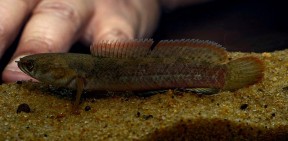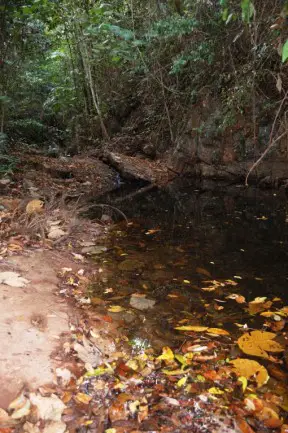Channa gachua
Dwarf Snakehead
SynonymsTop ↑
Ophicephalus gachua Hamilton, 1822; Ophiocephalus aurantiacus Hamilton, 1822; Ophicephalus marginatus Cuvier, 1829; Ophicephalus cora-mota Cuvier, in Cuvier & Valenciennes, 1831; Ophicephalus fuscus Cuvier, 1831; Ophicephalus limbatus Cuvier, 1831; Ophicephalus montanus M’Clelland & Griffith, in M’Clelland, 1842a; Philypnoides surakartensis Bleeker, 1849; Ophiocephalus gachua var. basalis Günther, 1861; Ophiocephalus apus Canestrini, 1861; Ophiocephalus kelaartii Günther, 1861; Ophiocephalus guachua var. malaccensis Peters, 1869
Etymology
Channa: from the Latin channe, used to refer to an unspecified species of sea perch.
gachua: appears to be derived from a Bengali vernacular name for the species.
Classification
Order: Perciformes Family: Channidae
Distribution
Currently considered to have an enormous natural range extending from Iran to Taiwan and Bali, with records existing from Iran, Iraq, Afghanistan, Pakistan, Nepal, India, Sri Lanka, Bangladesh, Bhutan, China, Myanmar, Thailand, Laos, Cambodia, Vietnam, Malaysia, Indonesia, and Singapore (but see ‘Notes’).
Type locality is ‘ponds and ditches of Bengal’, the latter name used historically in reference to a geographical region in the lower Ganges River basin now mostly divided between Bangladesh and the state of West Bengal, India.
Habitat
A generalist which has been collected in many different types of habitat, although it does tend to avoid very fast-flowing water.
Like others in the genus it can tolerate hypoxic conditions due to its ability to breath atmospheric air (see ‘Notes’).
Maximum Standard Length
150 – 200 mm.
Aquarium SizeTop ↑
An aquarium with base measuring at least 120 ∗ 45 cm is recommended.
Water depth is less important but should not be less than 30 cm.
Maintenance
Like most smaller Channa species it prefers a dimly-lit aquarium with plenty of cover in the form of live plants, driftwood branches, terracotta pipes, plant pots, etc., arranged to form a network of nooks, crannies, and shaded spots. Surface vegetation such as Ceratopteris spp. is also appreciated and makes the fish less inclined to conceal themselves.
It is essential to use a tightly-fitting cover since Channa spp. are notorious for their ability to escape, and a gap should be left between this and the water surface as they require access to a layer of humid air.
Water Conditions
Temperature: 18 – 28 °C. It is useful to know from where the fish derive, since populations from colder regions such as northern India are likely to require a cool period during winter, whereas those from the tropics should be happy with relatively constant temperatures.
pH: 5.0 – 8.0
Hardness: 18 – 357 ppm
Diet
An obligate predator feeding mostly on smaller fishes and insects in nature but in most cases adapting well to dead alternatives in captivity. Some specimens may accept dried foods although these should never form the staple diet.
Young fish can be offered chironomid larvae (bloodworm), small earthworms, chopped prawn and suchlike, while adults will accept strips of fish flesh, whole prawns, mussels, live river shrimp, larger earthworms, etc.
This species should not be fed mammalian or avian meat such as beef heart or chicken since some of the lipids contained in these cannot be properly metabolised by the fish and may cause excess fat deposits and even organ degeneration. Similarly there is no benefit in the use of ‘feeder’ fish such as livebearers or small goldfish which carry with them the risk of parasite or disease introduction, and tend not have a high nutritional value unless properly conditioned beforehand.
Behaviour and CompatibilityTop ↑
In general Channa are best-maintained in species-specific aquaria, although C. gachua can be kept in a well-chosen community arrangement alongside peaceful, non-territorial tankmates that are too large to be viewed as prey.
Young specimens can be maintained together but usually begin to display aggressive behaviour towards one another as they become sexually mature, although this does vary somewhat depending on the population (see ‘Distribution’).
If a pair forms they are usually peaceful towards one another but hostile to other conspecifics.
Sexual Dimorphism
In most populations males develop more-extended dorsal and anal fins than females, and sometimes a more intense colour pattern.
Females tend to grow larger than males and are deeper-bodied, especially when gravid.
Reproduction
A mouthbrooder which is bred on a regular basis in captivity.
Females of some populations are known to produce infertile eggs in order to feed the fry once they become free-swimming
Care must be taken not to mix populations as some may hybridise.
NotesTop ↑
There exists significant evidence to suggest that C. gachua as currently understood represents a complex of similar-looking species, and a taxonomic review of the group is clearly required. Ng et al. (1999) noted the presence of small black spots on the body of Indochinese specimens but not those from India and the Greater Sunda Islands, although Tan and Ng (2005) later observed similar patterning on specimens from Jambi province, Sumatra.
As things stand all populations are referred to as C. gachua and included together here, except one from Vietnam which has been described as Channa longistomata (Nguyen et al., 2012), while forms from Thailand and Peninsular Malaysia are sometimes referred to using the invalid name C. limbata (Cuvier, 1831).
It has often been confused with the congener C. orientalis, but that species is endemic to Sri Lanka and lacks pelvic fins.
Members of the family Channidae are commonly referred to as ‘snakeheads’ due to possession of large scales on the head of most species which are reminiscent of the epidermal scales (cephalic plates) on the heads of snakes. There currently exist over 30 valid species but diversity within the group is likely to prove significantly greater.
The existence of distinct phylogenetic groups has been proposed with the putative C. gachua species assemblage of Britz (2008) containing C. orientalis, C. gachua, C. bleheri, C. burmanica, C. barca, C. aurantimaculata, and C. stewartii. Species from northeastern India have also been divided into the C. marulius and C. gachua groups (Vishwanath and Geetakumari, 2009).
The latter is characterised by the following combination of characters: presence of a U-shaped isthmus; cephalic sensory pores evenly arranged in a single row; presence of one or two large cycloid scales on each side of the lower jaw; absence of a sharp prominent spine-like hypurapophysis; absence or presence of one tooth plate in the epibranchial; absence of an elongated urostyle.
The fish used in the study should represent C. gachua sensu stricto based on their origin, and were distinguished from other Channa species from northern India by the following characters: u-shaped isthmus; cephalic pores arranged singly; pelvic-fins present; tooth plates present on both sides of first gill arch; pectoral-fin with transverse black bars; sides of body without numerous black spots; no bars on upper portion of body; 45-46 lateral scales.
The second-last point is slightly at odds with Hamilton’s original description which mentions that ‘Several dark belts run across the back to the lateral lines, descending obliquely forward.’
All Channa spp. possess supplementary breathing apparatus in the form of paired suprabranchial chambers located behind and above the gills, although these are not labyrinthic but lined with respiratory epithelium. These chambers allow the fish to breathe atmospheric air and survive in hypoxic conditions or even out of the water for a considerable period of time, and in aquaria they are often seen rising to the surface to take gulps of air.
References
- Hamilton, F., 1822 - Edinburgh & London: i-vii + 1-405
An account of the fishes found in the river Ganges and its branches. - Brede, N. and P. Antler, 2009 - Natur und Tier Verlag, Münster: 62 pp.
Schlangenkopffische—Die Gattungen Channa und Parachanna. - Britz, R., 2008 - Ichthyological Exploration of Freshwaters 8(4) [for 2007]: 335-344
Channa ornatipinnis and C. pulchra, two new species of dwarf snakeheads from Myanmar (Teleostei: Channidae). - Freyhof, J., D. V. Serov and T. N. Nguyen, 2000 - Bonner Zoologische Beiträge 49(1-4): 93-99
A preliminary checklist of the freshwater fishes of the River Dong Nai, South Vietnam. - Kottelat, M., 2001 - WHT Publications, Colombo: 1-198
Fishes of Laos. - Kottelat, M., 2001 - Environment and Social Development Unit, East Asia and Pacific Region. The World Bank: i-iii + 1-123 + 1-18
Freshwater fishes of northern Vietnam. A preliminary check-list of the fishes known or expected to occur in northern Vietnam with comments on systematics and nomenclature. - Kottelat, M., 2000 - Journal of South Asian Natural History 5(1): 95-96
Nomenclature and types of Ophicephalus marginatus and O. limbatus (Teleostei: Channidae). - Kottelat, M., 2013 - Raffles Bulletin of Zoology Supplement 27: 1-663
The fishes of the inland waters of southeast Asia: a catalogue and core bibiography of the fishes known to occur in freshwaters, mangroves and estuaries. - Ng, H. H. and H.-H. Tan, 1999 - Zoological Studies 38(3): 350-366
The fishes of the Endau drainage, Peninsular Malaysia with descriptions of two new species of catfishes (Teleostei: Akysidae, Bagridae). - Ng, H. H., P. K. L. Ng and R. Britz, 1999 - Journal of South Asian Natural History 4(1): 57-63
Channa harcourtbutleri (Annandale, 1918): a valid species of snakehead (Perciformes: Channidae) from Myanmar. - Nguyen, V. H., T. H. T. Nguyen and T. D. P. Nguyen, 2012 - Journal of Biology (Vietnam) 34(2): 145-157
A new species of the walking snakehead group, the genus Channa (Channidae, Perciformes) in Vietnam. - Parenti, L. R. and K. K. P. Lim, 2005 - The Raffles Bulletin of Zoology Supplement 13: 175-208
Fishes of the Rajang Basin, Sarawak, Malaysia. - Tan, H. H. and P. K. L. Ng, 2005 - The Raffles Bulletin of Zoology Supplement 13: 115-138
The labyrinth fishes (Teleostei: Anabanatoidei, Channoidei) of Sumatra, Indonesia. - Vishwanath, W. and Kh. Geetakumari , 2009 - Journal of Threatened Taxa 1(2): 97-105
Diagnosis and interrelationships of fishes of the genus Channa Scopoli (Teleostei: Channidae) of northeastern India.














































